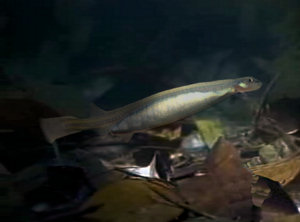
Why you lock your doors down on the bayou.
Posted on 02/13/2009 2:09:52 PM PST by JoeProBono
Goliath tiger fish, such as the one seen above, are among the uniquely adapted "monster fish" of the Congo River, which winds through several African countries. A recent, unprecedented river run on the Congo yielded a raft of new discoveries, including different species--some potentially new--in nearly every nook and cranny, scientists announced this week.The river was also found to be possibly the world's deepest, and its extraordinary changes in depths and currents help explain why it's such a hotbed of fish diversity.
(Excerpt) Read more at news.nationalgeographic.com ...
On second thought, you understand that I do not do Alligator Gar, they are too big, strong tasting , and bony to be good.
They also stink.
Now Needlenose gar, are OK if fixed right.
But they really fight.
I like it. Looks like someone else likes crushed red pepper.
I have read articles on fly fishing for Tiger fish on the Congo River. I think it would be fun, in Kevlar waders of course.
That sounds good to me. Send some over;-)
The psychologically blind lack the synapses to see

Why you lock your doors down on the bayou.
<No noodling for that one.
The first time I saw noodling (I think on ‘Dirty Jobs’), I was dumbfounded. All I could was think, “Hell, no.” The noodlers looked like they were having fun, tho.
Sounds fishy to me. Bigger and more savage and that’s ‘evolution’? Where are the hospitals these things have built? If Maslow and Darwin were correct, these things are merely meaner and sadly unactualized... (sniff)
Here is evolution in a way you never thought possible.
This article explains the interesting animal known as the toothpick fish and its interesting response to something as innocuous as relieving yourself under water.
http://www.damninteresting.com/?p=797


Evolution in Your FaceLake Victoria, Africa's largest lake, is home to more than 300 species of cichlids. These fish, which are popular in aquariums, are deep-bodied and have one nostril, rather than the usual two, on each side of the head. Seismic profiles and cores of the lake taken by a team headed by Thomas C. Johnson of the University of Minnesota, reveal that the lake dried up completely about 12,400 years ago. This means that the rate of speciation of cichlid fishes has been extremely rapid: something on average of one new species every 40 years!
by Patrick Huyghe
Omni
Ping
.gif)

Disclaimer: Opinions posted on Free Republic are those of the individual posters and do not necessarily represent the opinion of Free Republic or its management. All materials posted herein are protected by copyright law and the exemption for fair use of copyrighted works.